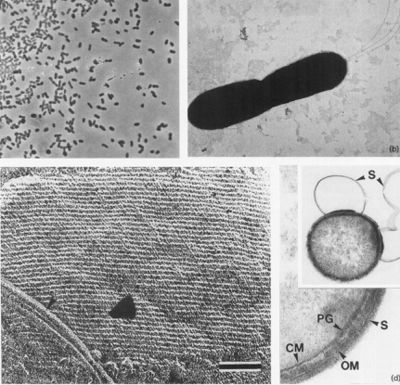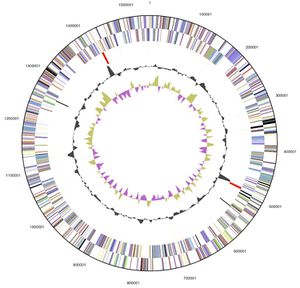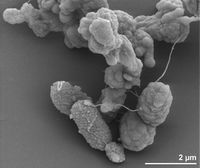Desulfurobacterium: Difference between revisions
No edit summary |
No edit summary |
||
| Line 49: | Line 49: | ||
==Genome Structure== | ==Genome Structure== | ||
[[File:Desulfuro Genome.jpg|thumb|left|300px|<strong>Figure 2.</strong> Graphical circular map of the genome. From bottom to top: Genes on forward strand (color by COG categories), Genes on reverse strand (color by COG categories), RNA genes (tRNAs green, rRNAs red, other RNAs black), GC content, GC skew.]] | [[File:Desulfuro Genome.jpg|thumb|left|300px|<strong>Figure 2.</strong> Graphical circular map of the genome. From bottom to top: Genes on forward strand (color by COG categories), Genes on reverse strand (color by COG categories), RNA genes (tRNAs green, rRNAs red, other RNAs black), GC content, GC skew.]] | ||
<strong>Genome Size:</strong> 1 circular chromosome, with a length of 1.54 Mb (1,541,968 base pairs long), 1,594 genes, 1,543 protein-coding regions (96.80%), G+C Content= ~35%. 34 of the genes (2.13%) are also known to be pseudo genes, however 1,204 (75.53%) of the total genes have a predicted function with reasonable certainty (Göker et. al., 2011) | <strong>Genome Size:</strong> 1 circular chromosome, with a length of 1.54 Mb (1,541,968 base pairs long), 1,594 genes, 1,543 protein-coding regions (96.80%), G+C Content= ~35% (Göker et. al., 2011). | ||
--> 34 of the genes (2.13%) are also known to be pseudo genes, however 1,204 (75.53%) of the total genes have a predicted function with reasonable certainty (Göker et. al., 2011) | |||
<strong>Interesting Features:</strong> On the 16s rRNA sequence, between positions 198-219, there is a CUC bulge characteristic of the aquificales lineage (Göker et. al., 2011). The observation of this phenomenon has led to recent discrepancy as to which specific classification order the species should be included. | <strong>Interesting Features:</strong> On the 16s rRNA sequence, between positions 198-219, there is a CUC bulge characteristic of the aquificales lineage (Göker et. al., 2011). The observation of this phenomenon has led to recent discrepancy as to which specific classification order the species should be included. | ||
Revision as of 20:03, 28 April 2015
Desulfurobacterium thermolithotrophum
Classification
Domain: Bacteria
Phylum: Aquificae
Class: Aquificae
Order: Desulfurobacteriales
Family: Desulfurobacteriaceae
Genus: Desulfurobacterium
Species
Desulfurobacterium thermolithotrophum
Related Species:
Desulfurobacterium atlanticum, Desulfurobacterium crinifex, Desulfurobacterium pacificum
|
NCBI: Taxonomy |
Description and Significance

Appearance:
Cells appear as small rods, about 1-2 µm long and 0.4-0.5 µm wide (seen in Figure 1a and b) and are stained as Gram-negative. These cells can occur either singly or in pairs, and are observed to be highly motile. Through negative staining, up to three flagella could be observed under a microscope. Moreover, during the stationary growth phase, some rods become spherical (L'Haridon et. al., 1998).
Habitat:
Desulfurobacterium thermolithotrophum are anaerobic chemolithoautotrophs, typically found in hot, deep-sea hydrothermal vents, such as the Snake Pit vent field of the Mid-Atlantic Ridge. These thermophiles are capable of survival in temperatures ranging from 40°-75°C, but prefer an optimal temperature of 70°C. In addition to a tolerance to a variety of temperatures, this strain has also been observed (in vitro) to survive in conditions ranging from a pH of 4.4-8.0, with an optimal pH level of 6.0. A medium of salt concentration 35 g/L would be most preferred by this species for cultivation, yet a range of 15-70 g/L would also be suitable for growth. Given these optimal conditions are met, the experimentally observed doubling time was ~135 minutes (L'Haridon et. al., 1998).
Significance:
Most extremely thermophilic microorganisms that are found in deep-sea hydrothermal vents are archaea species. However, Desulfurobacterium thermolithotrophum is the first bacteria capable of serving as a primary producer in such an environmental conditions (L'Haridon et. al., 1998).
Describe the appearance, habitat, etc. of the organism, and why you think it is important.
Genome Structure
Genome Size: 1 circular chromosome, with a length of 1.54 Mb (1,541,968 base pairs long), 1,594 genes, 1,543 protein-coding regions (96.80%), G+C Content= ~35% (Göker et. al., 2011).
--> 34 of the genes (2.13%) are also known to be pseudo genes, however 1,204 (75.53%) of the total genes have a predicted function with reasonable certainty (Göker et. al., 2011)
Interesting Features: On the 16s rRNA sequence, between positions 198-219, there is a CUC bulge characteristic of the aquificales lineage (Göker et. al., 2011). The observation of this phenomenon has led to recent discrepancy as to which specific classification order the species should be included.
Describe the size and content of the genome. How many chromosomes? Circular or linear? Other interesting features? What is known about its sequence?
Cell Structure, Metabolism and Life Cycle
Interesting features of cell structure; how it gains energy; what important molecules it produces.
Ecology and Pathogenesis
Habitat; symbiosis; biogeochemical significance; contributions to environment.
If relevant, how does this organism cause disease? Human, animal, plant hosts? Virulence factors, as well as patient symptoms.
References
1. L'Haridon S, Cilia V, Messner P, Raguénès G, Gambacorta A, Sleytr UB, Prieur D, Jeanthon C. Desulfurobacterium thermolithotrophum gen. nov., sp. nov., a novel autotrophic, sulphur-reducing bacterium isolated from a deep-sea hydrothermal vent. International Journal of Systematic Bacteriology , 1998; 48:701-711. PubMed
2. Göker M, Daligault H, Mwirichia R, et al. Complete genome sequence of the thermophilic sulfur-reducer Desulfurobacterium thermolithotrophum type strain (BSAT) from a deep-sea hydrothermal vent. Standards in Genomic Sciences. 2011;5(3):407-415. PubMed
Author
Page authored by William Van Cleef III & Meghan Von Holt, students of Professor Jay Lennon at Indiana University Bloomington.


